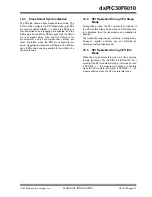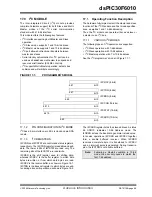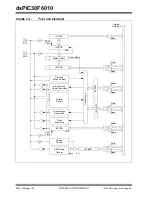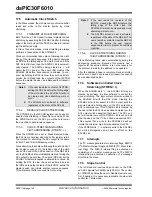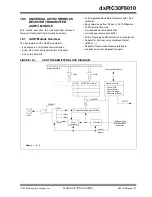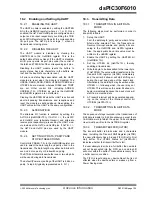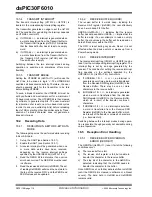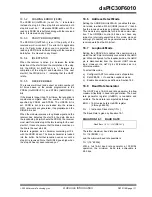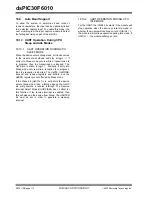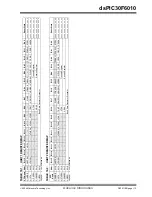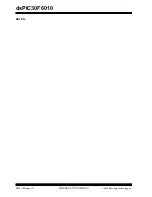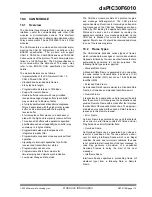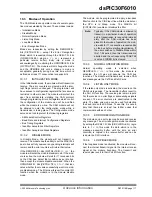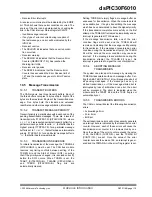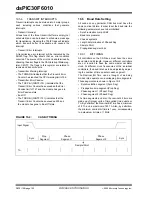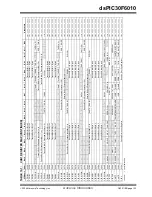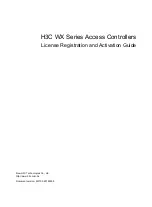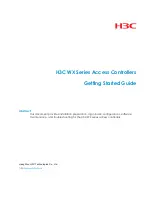
2004 Microchip Technology Inc.
Advance Information
DS70119B-page 111
dsPIC30F6010
18.5.2
FRAMING ERROR (FERR)
The FERR bit (UxSTA<2>) is set if a ‘
0
’ is detected
instead of a stop bit. If two stop bits are selected, both
stop bits must be ‘
1
’, otherwise FERR will be set. The
read only FERR bit is buffered along with the received
data. It is cleared on any Reset.
18.5.3
PARITY ERROR (PERR)
The PERR bit (UxSTA<3>) is set if the parity of the
received word is incorrect. This error bit is applicable
only if a Parity mode (odd or even) is selected. The
read only PERR bit is buffered along with the received
data bytes. It is cleared on any Reset.
18.5.4
IDLE STATUS
When the receiver is active (i.e., between the initial
detection of the start bit and the completion of the stop
bit), the RIDLE bit (UxSTA<4>) is ‘
0
’. Between the
completion of the stop bit and detection of the next
start bit, the RIDLE bit is ‘
1
’, indicating that the UART
is Idle.
18.5.5
RECEIVE BREAK
The receiver will count and expect a certain number of
bit times based on the values programmed in the
PDSEL (UxMODE<2:1>) and STSEL (UxMODE<0>)
bits.
If the break is longer than 13 bit times, the reception is
considered complete after the number of bit times
specified by PDSEL and STSEL. The URXDA bit is
set, FERR is set, zeros are loaded into the receive
FIFO, interrupts are generated, if appropriate and the
RIDLE bit is set.
When the module receives a long break signal and the
receiver has detected the start bit, the data bits and
the invalid stop bit (which sets the FERR), the receiver
must wait for a valid stop bit before looking for the next
start bit. It cannot assume that the break condition on
the line is the next start bit.
Break is regarded as a character containing all 0’s,
with the FERR bit set. The break character is loaded
into the buffer. No further reception can occur until a
stop bit is received. Note that RIDLE goes high when
the stop bit has not been received yet.
18.6
Address Detect Mode
Setting the ADDEN bit (UxSTA<5>) enables this spe-
cial mode, in which a 9th bit (URX8) value of ‘
1
’ identi-
fies the received word as an address rather than data.
This mode is only applicable for 9-bit data communica-
tion. The URXISEL control bit does not have any
impact on interrupt generation in this mode, since an
interrupt (if enabled) will be generated every time the
received word has the 9th bit set.
18.7
Loopback Mode
Setting the LPBACK bit enables this special mode in
which the UxTX pin is internally connected to the UxRX
pin. When configured for the loopback mode, the UxRX
pin is disconnected from the internal UART receive
logic. However, the UxTX pin still functions as in a
normal operation.
To select this mode:
a)
Configure UART for desired mode of operation.
b)
Set LPBACK =
1
to enable Loopback mode.
c)
Enable transmission as defined in Section 18.3.
18.8
Baud Rate Generator
The UART has a 16-bit baud rate generator to allow
maximum flexibility in baud rate generation. The baud
rate generator register (UxBRG) is readable and
writable. The baud rate is computed as follows:
BRG = 16-bit value held in UxBRG register
(0 through 65535)
F
CY
= Instruction Clock Rate (1/T
CY
)
The Baud Rate is given by Equation 18-1.
EQUATION 18-1: BAUD RATE
Therefore, maximum baud rate possible is
F
CY
/16 (if BRG =
0
),
and the minimum baud rate possible is
F
CY
/ (16* 65536).
With a full 16-bit baud rate generator, at 30 MIPs
operation, the minimum baud rate achievable is
28.5 bps.
Baud Rate = F
CY
/ (16*(BRG+1))
Summary of Contents for dsPIC30F6010
Page 12: ...dsPIC30F6010 DS70119B page 10 Advance Information 2004 Microchip Technology Inc NOTES...
Page 32: ...dsPIC30F6010 DS70119B page 30 Advance Information 2004 Microchip Technology Inc NOTES...
Page 38: ...dsPIC30F6010 DS70119B page 36 Advance Information 2004 Microchip Technology Inc NOTES...
Page 50: ...dsPIC30F6010 DS70119B page 48 Advance Information 2004 Microchip Technology Inc NOTES...
Page 68: ...dsPIC30F6010 DS70119B page 66 Advance Information 2004 Microchip Technology Inc NOTES...
Page 72: ...dsPIC30F6010 DS70119B page 70 Advance Information 2004 Microchip Technology Inc NOTES...
Page 76: ...dsPIC30F6010 DS70119B page 74 Advance Information 2004 Microchip Technology Inc NOTES...
Page 86: ...dsPIC30F6010 DS70119B page 84 Advance Information 2004 Microchip Technology Inc NOTES...
Page 108: ...dsPIC30F6010 DS70119B page 106 Advance Information 2004 Microchip Technology Inc NOTES...
Page 116: ...dsPIC30F6010 DS70119B page 114 Advance Information 2004 Microchip Technology Inc NOTES...
Page 128: ...dsPIC30F6010 DS70119B page 126 Advance Information 2004 Microchip Technology Inc NOTES...
Page 150: ...dsPIC30F6010 DS70119B page 148 Advance Information 2004 Microchip Technology Inc NOTES...
Page 164: ...dsPIC30F6010 DS70119B page 162 Advance Information 2004 Microchip Technology Inc NOTES...
Page 208: ...dsPIC30F6010 DS70119B page 206 Advance Information 2004 Microchip Technology Inc NOTES...
Page 220: ...dsPIC30F6010 DS70119B page 220 Advance Information 2004 Microchip Technology Inc NOTES...
Page 221: ...2004 Microchip Technology Inc Advance Information DS70119B page 221 dsPIC30F6010 NOTES...

